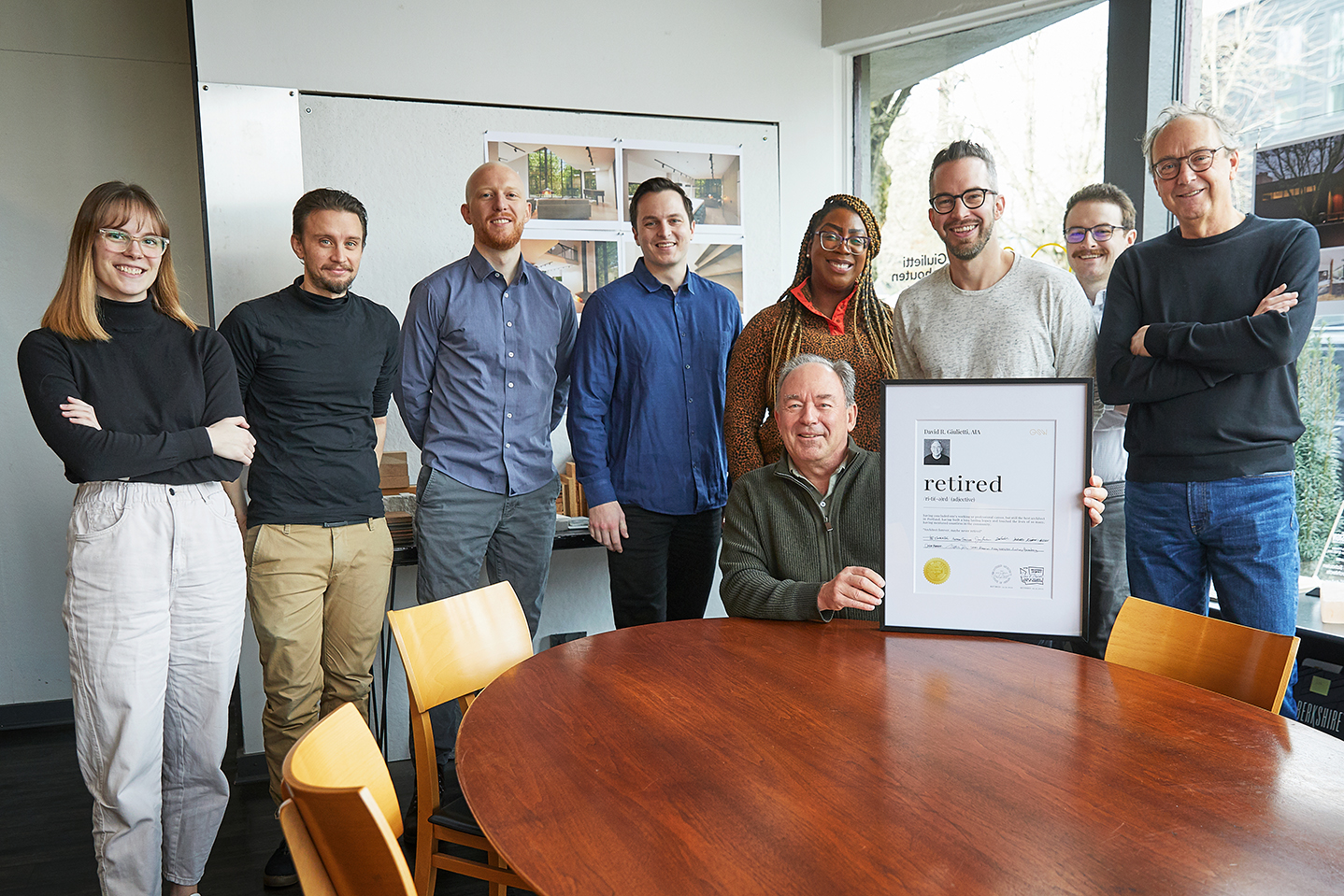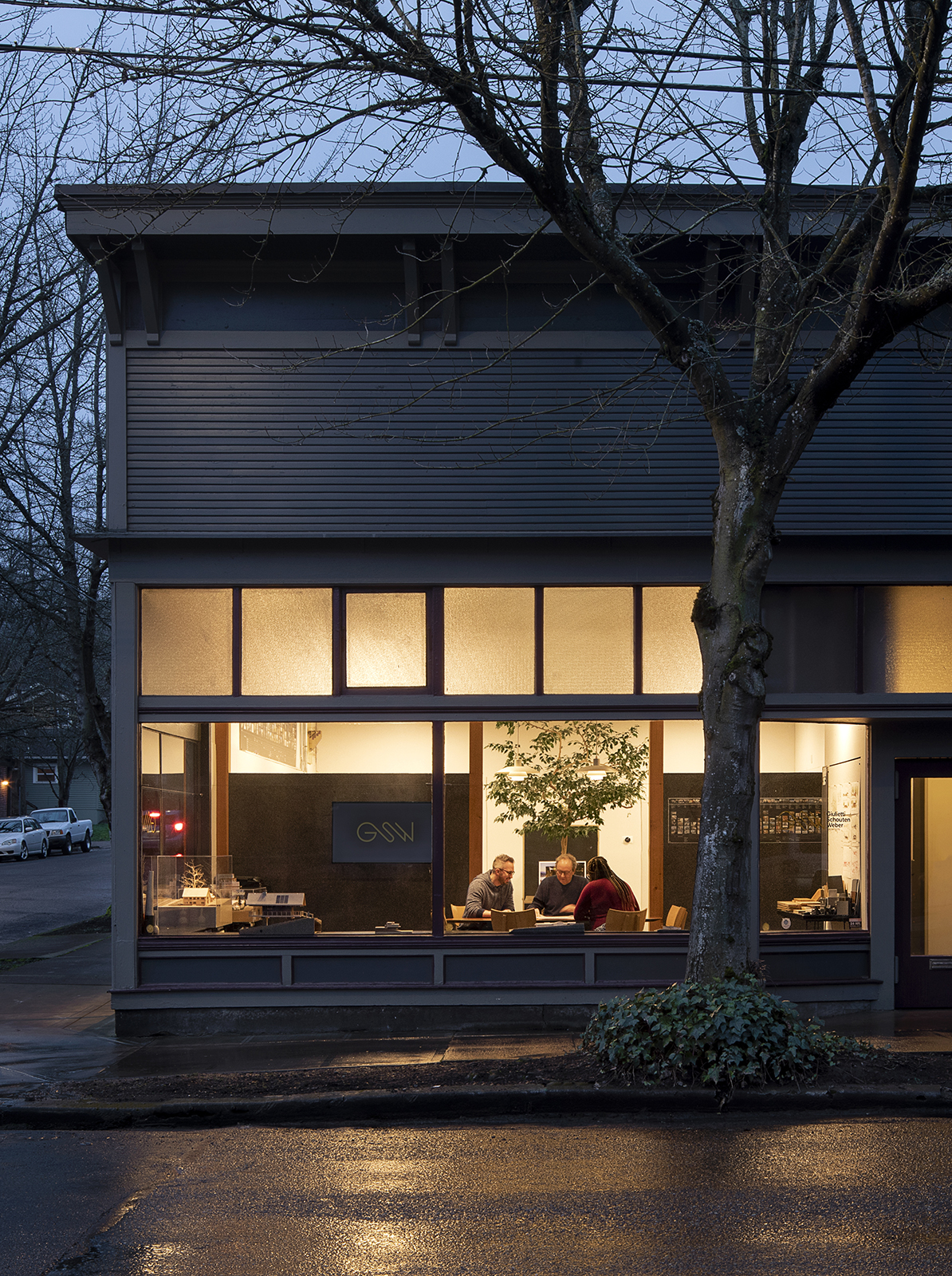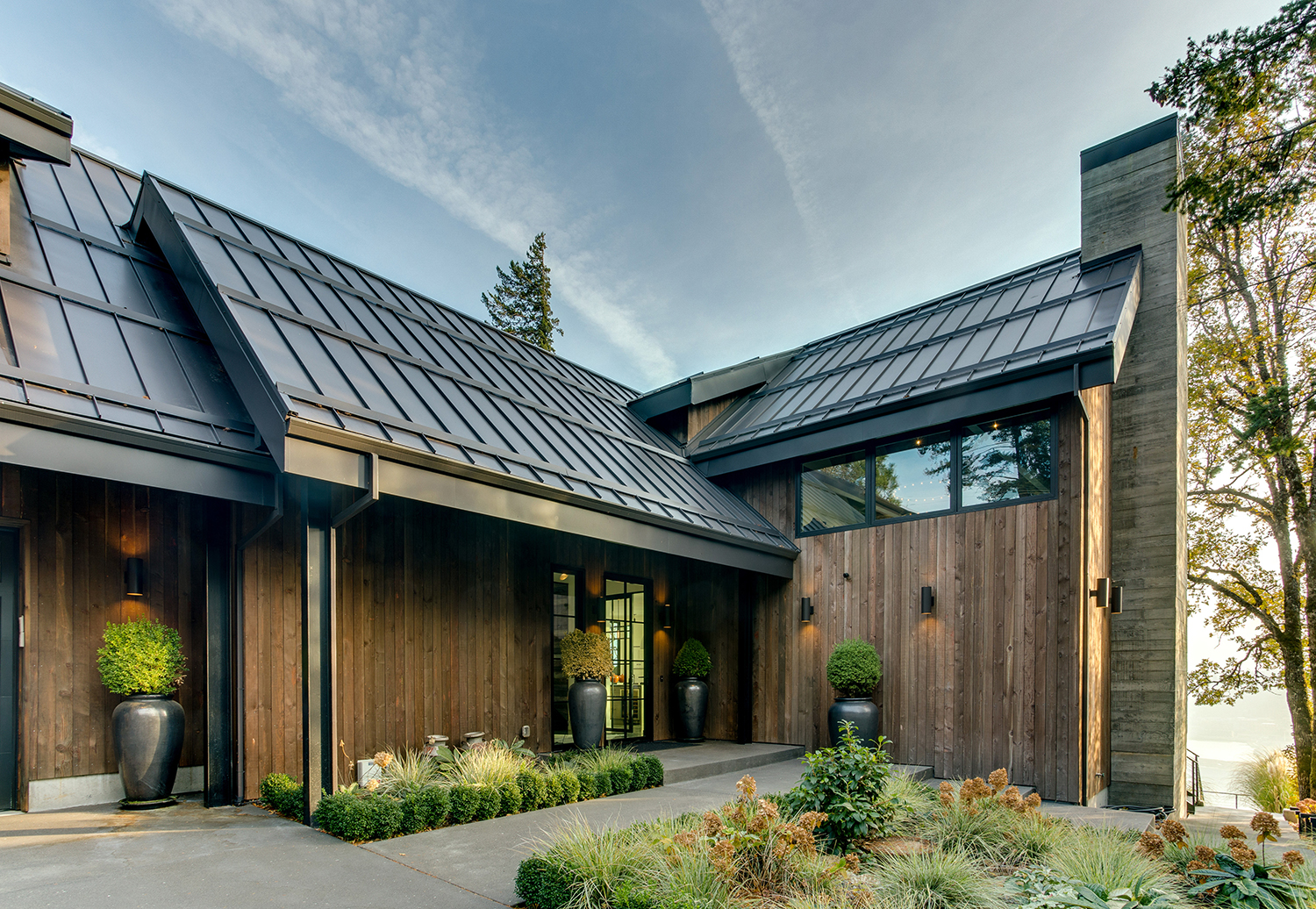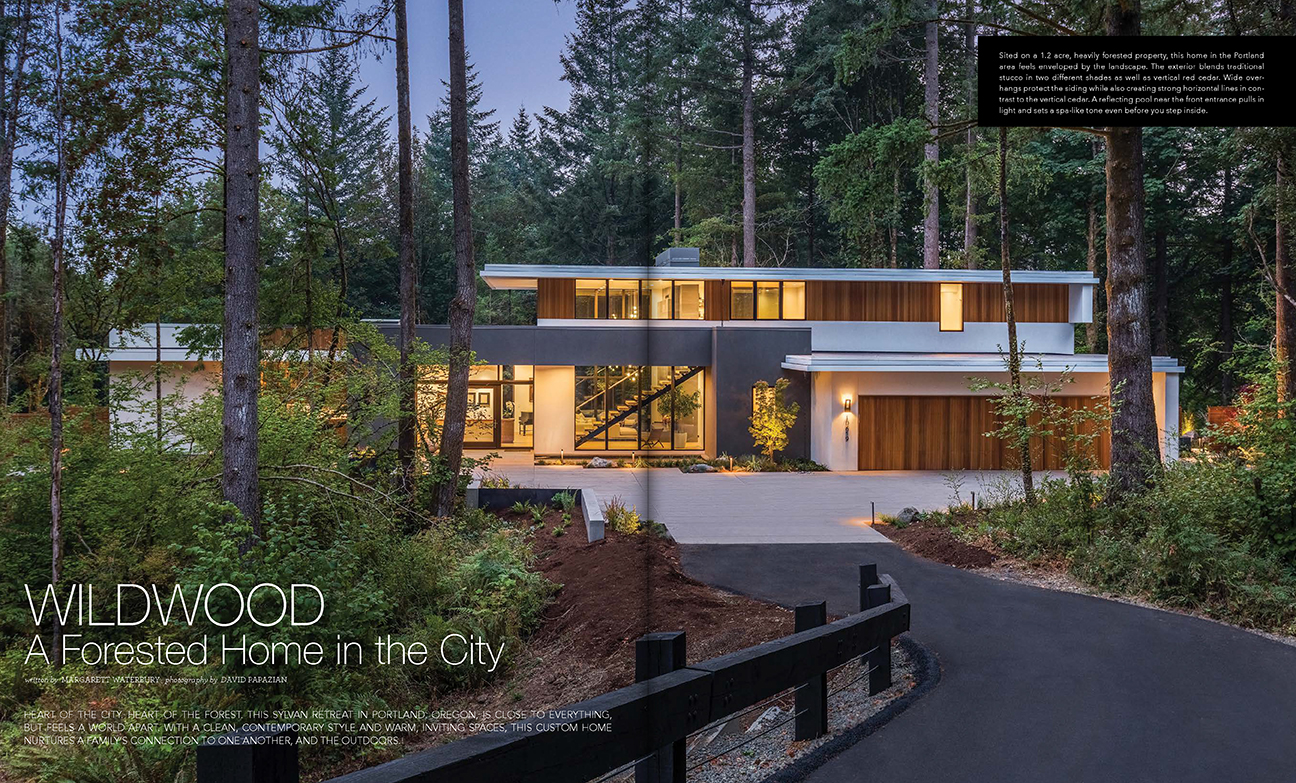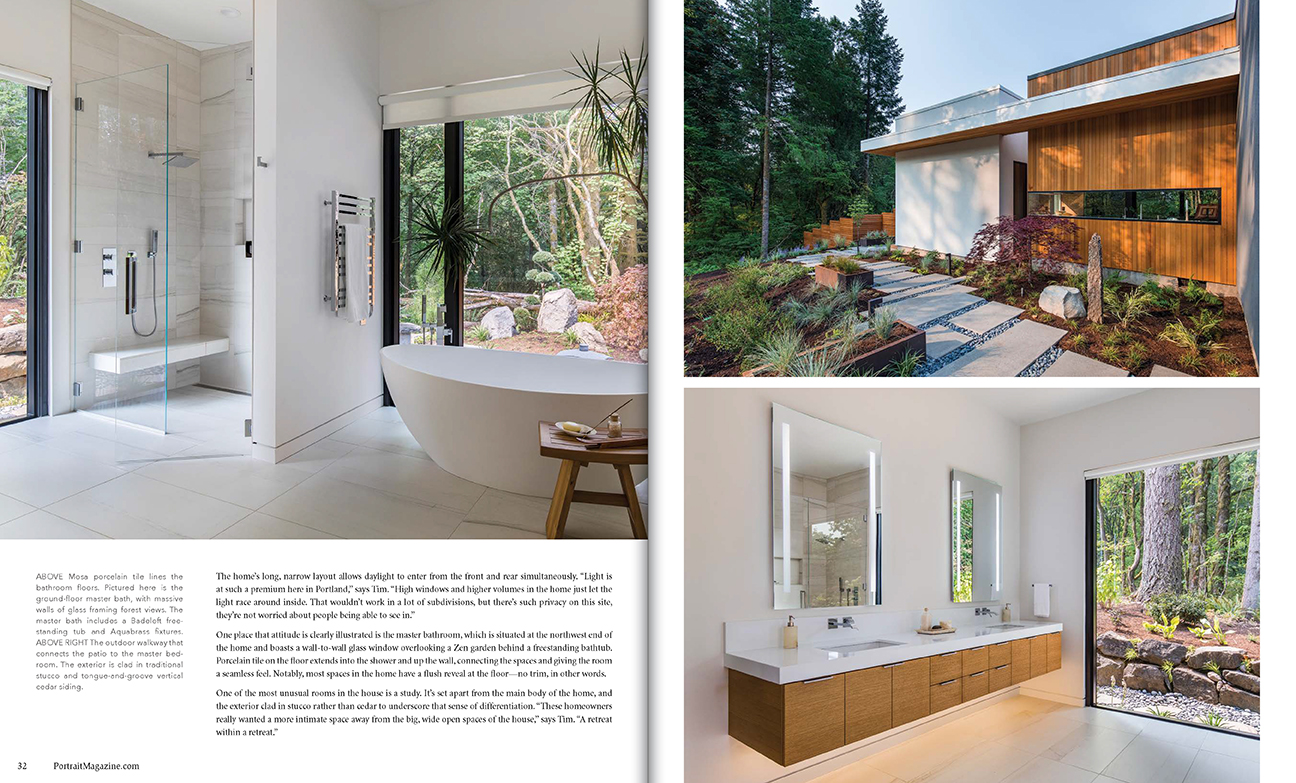 While Giulietti Schouten Weber Architects celebrated its 35th Anniversary in 2022, we knew the day would finally come when Dave would officially retire. That day has come and as of January 2023, Dave has transitioned to one day per week. It’s not a complete retirement, yet, but of course eventually it will be. He’s been such an instrumental architect, mentor, and friend over the past three and a half decades to everyone connected to the firm as well as the Portland architectural community. He will be greatly missed at the firm, but this is also a moment to celebrate. Dave is the consummate architect, but because he’s an even better person, his impact will continue to be felt in many a season to come.
While Giulietti Schouten Weber Architects celebrated its 35th Anniversary in 2022, we knew the day would finally come when Dave would officially retire. That day has come and as of January 2023, Dave has transitioned to one day per week. It’s not a complete retirement, yet, but of course eventually it will be. He’s been such an instrumental architect, mentor, and friend over the past three and a half decades to everyone connected to the firm as well as the Portland architectural community. He will be greatly missed at the firm, but this is also a moment to celebrate. Dave is the consummate architect, but because he’s an even better person, his impact will continue to be felt in many a season to come.
Tributes to Dave Giulietti
BRIAN LIBBY
Dave Giulietti has rounded the bases and is headed for home plate.
A talented baseball player in his youth, Dave has spent the past 35 years leading a prosperous and beloved Portland architecture firm of his own founding. While countless magazine covers and design awards speak to his ability as a designer, as Dave reaches retirement this year, it’s the outpouring of support from across the community—from fellow architects to builders, from clients to his many friends—that speaks to what a great team captain Dave has always been.
Put it this way: if Dave Giulietti is retiring, GSW Architects will be retiring his jersey too. First, though, a few of Dave’s friends, collaborators and colleagues would like to pay tribute.
From New York to Portland (Jonah Cohen)
 Raised in Queens, New York during the late Sixties and early Seventies, Dave first got passionate about architecture after enrolling at City College in Harlem, each day making a three-hour round trip via subway. He worked his way through college, at New York firm Rothzeid Kaiserman Thomson & Bee (today known as RKTB Architects) and was offered a full-time job upon graduation in 1979. But Dave dreamed of going west. A few years later, he flew to San Francisco, bought a cheap used car and drove up and down the West Coast, and picked Portland over San Diego.
Raised in Queens, New York during the late Sixties and early Seventies, Dave first got passionate about architecture after enrolling at City College in Harlem, each day making a three-hour round trip via subway. He worked his way through college, at New York firm Rothzeid Kaiserman Thomson & Bee (today known as RKTB Architects) and was offered a full-time job upon graduation in 1979. But Dave dreamed of going west. A few years later, he flew to San Francisco, bought a cheap used car and drove up and down the West Coast, and picked Portland over San Diego.
Dave was first hired at Portland architecture firm BOOR/A (today known as Bora) in 1981. The job captain for his first project was Jonah Cohen, who also hailed from New York and even shared a teacher-mentor in Carmi Bee, FAIA, a partner in Dave’s old firm. Years later, Jonah would be the best man at Dave’s wedding.
Early on, Jonah remembers Dave striking a chord both in and out of work. They started a softball league together, and naturally Dave served as player-manager. “I’ll never forget it,” Jonah remembers today with a chuckle. “He got us all together and said, ‘You can make all the physical mistakes you want out there. But no mental errors.’”
At work, Dave distinguished himself too, not just on projects for clients like the US Veterans Administration and the Oregon Department of Transportation, but also in tackling how the firm operated. When BOOR/A leaders announced a contest meant to generate ideas for how to run the business more efficiently, “Dave just completely analyzed every aspect of the firm, even down to things like the distance between where the pencil leads were stored and architects’ desks,” Jonah remembers. “He came up with about 50 or 60 different ideas. He blew everyone else away.”
As New Yorkers embracing Oregon’s natural beauty, Jonah and Dave didn’t just go camping together. They went snow-camping. Jonah remembers waking one morning, unzipping the tent, and finding Dave had carved out of the snow a little outdoor room for them to cook and eat breakfast in, complete with contoured seating.
Dave and Jonah wanted to start their own firm, which would have been called Oxalis Architecture (after the flowering plant). They set their sights not just on design but development, specifically the industrial Northwest Portland neighborhood just beyond downtown that was just beginning to be called the Pearl District.
“Coming from New York, we saw the potential in all these warehouses for residential, because we’d seen that in SoHo,” Jonah remembers. They met with the owner of a circa-1906 warehouse at NW 13th and Glisan, who welcomed their redevelopment suggestion, but didn’t seem to take them seriously. A few years later, though, the pioneering Jamison/Thomas Gallery moved into the building, birthing the Pearl’s new era as an arts and residential Mecca. “We were ten years ahead,” Jonah says. “But we saw it.”
A Natural Collaborator (Tim Schouten and Dave Lyons)
 Dave founded his own firm in 1987, finding success with designs like the Waymire Residence, co-designed with David Gonrowski. Its blend of contemporary style with hints of Bauhaus and Art Deco won a People’s Choice Award at the AIA Portland Design Awards in 1989. Three years in, Dave rented the storefront on Northwest Thurman Street that remains the firm’s home today, a former neighborhood grocer that had also previously held the offices of architect Edgar Waehrer.
Dave founded his own firm in 1987, finding success with designs like the Waymire Residence, co-designed with David Gonrowski. Its blend of contemporary style with hints of Bauhaus and Art Deco won a People’s Choice Award at the AIA Portland Design Awards in 1989. Three years in, Dave rented the storefront on Northwest Thurman Street that remains the firm’s home today, a former neighborhood grocer that had also previously held the offices of architect Edgar Waehrer.
GSW Architects principal Tim Schouten joined the firm in 1993. After several years at Portland’s SERA Architects and a large firm in California, this was a chance to work holistically and take more responsibility in a smaller firm. “I really got the sense that it could be long-term, and it would allow me to evolve and grow as an architect,” Tim says. One of their acclaimed early projects, 1995’s Parsons Residence, featured a unique yet traditional look: three distinct gabled wings configured around a central South facing court/patio.
Tim loved to draw and visualize new designs, and “I saw that as very complementary to Dave’s skills,” he explains. “Dave’s passion is the relationships and a personalized service that’s really unique to the single-family market. I think that’s a testament to how we have survived over the years. It takes a certain type of personality, who puts people at ease during a very complex journey. Being able to explain that process in a way that’s easily understandable, people gravitate towards that. That’s a special quality Dave has.”
Tim also believes Dave helped him become a more responsive architect, able to visualize designs that also articulated clients’ wishes. “I always remember early on, Dave would tell me, ‘That’s a really good design. But remember, we promised the client we would do this.’ That was a hard thing to learn. But now I’m often the one telling architects here, ‘We have to solve what the client expects us to be showing them first, and then we can show these other options.”
Dave has also been a favorite of general contractors, many of whom the firm worked with several times, such as JDL Development and co-owners Dave and Joe Lyons.
“We very much appreciated that working relationship,” says Dave Lyons. “I don’t recall ever going to loggerheads with Dave on a project, and we did a lot of work together. He was always up for discussing methods, and didn’t care too much about how we got there. He also didn’t feel that he had to drive the bus. We were all in it together, and it brought out the best in our company.”
Lyons remembers working with GSW on 2007’s acclaimed Walnut House in Yamhill County outside McMinnville, a contemporary residence dramatically cantilevering over its rural hillside; the project was ultimately featured in three different magazines. “They tested us all the time to find ways to achieve what they were trying to achieve,” Dave Lyons says. “Their creativity and vision forced us to stretch ourselves as contractors, which made us better. Working with Dave and Tim exposed us to projects that were better budgeted and more discerning clients.”
Dave Lyons thought highly enough of his working relationship with GSW that he and his commissioned the firm to design renovations to their own home—twice. “Both turned out great,” he adds.
Giving Back (Saundra Stevens)
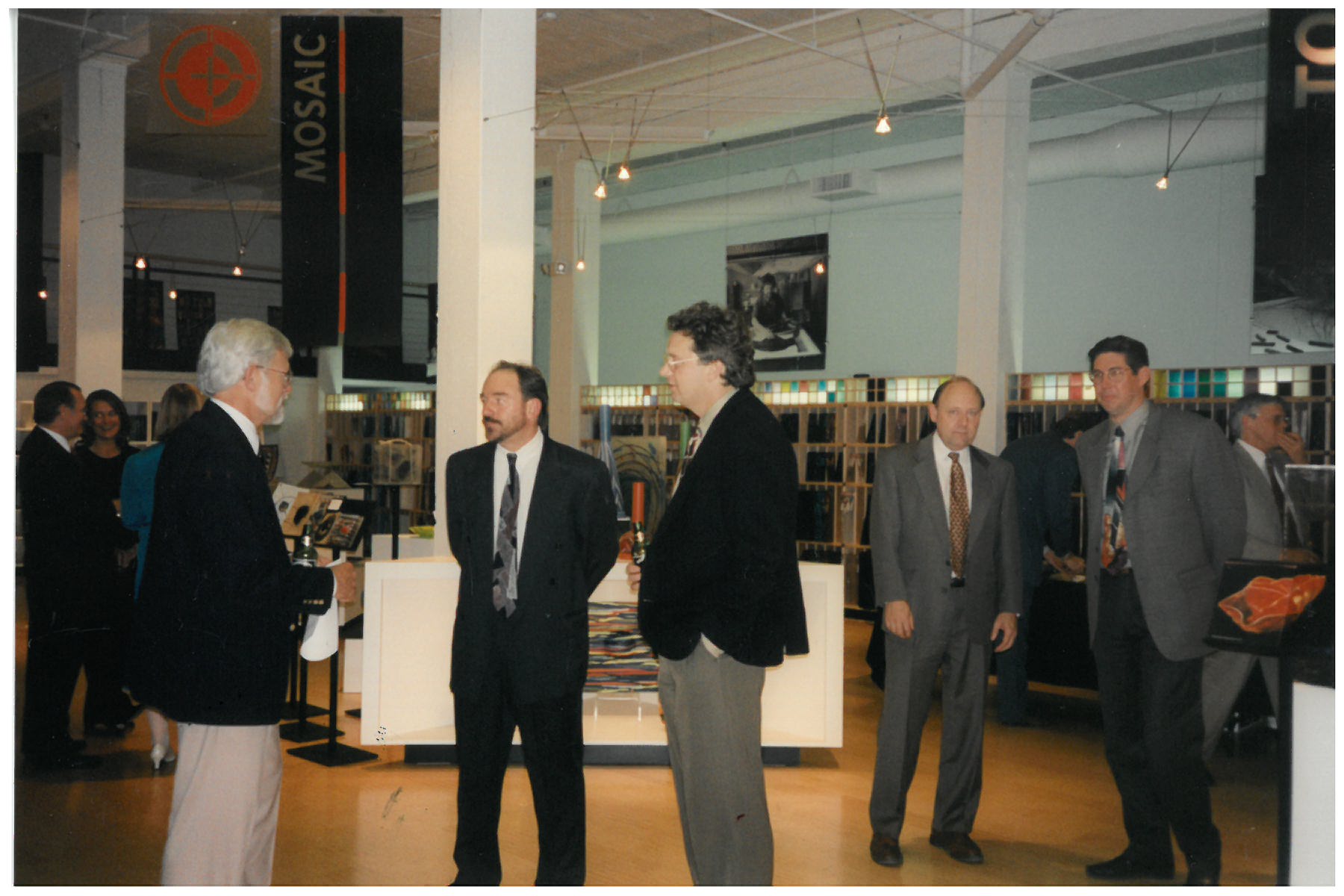 The story of Dave Giulietti’s career would not be complete without mentioning his many years of volunteering with the American Institute of Architects’ Portland chapter. In 1998, after a number of years on the chapter’s board of directors, Dave became the AIA Portland president. But that was just the start. He also helped co-found the chapter’s Small Firm Roundtable, spearheaded the creation of a local-architecture-firms directory, and annually during Architecture Week would host a seminar for the public called “How to Hire and Work with an Architect.”
The story of Dave Giulietti’s career would not be complete without mentioning his many years of volunteering with the American Institute of Architects’ Portland chapter. In 1998, after a number of years on the chapter’s board of directors, Dave became the AIA Portland president. But that was just the start. He also helped co-found the chapter’s Small Firm Roundtable, spearheaded the creation of a local-architecture-firms directory, and annually during Architecture Week would host a seminar for the public called “How to Hire and Work with an Architect.”
“I think really the whole time that I worked with AIA he was in and out. He was really committed to advancing the profession. I really admire him for that because a lot of times, you might rise up through the ranks because you’re trying to go for partner or you’re just trying to get some AIA involvement on your resume. But he was not like that. He was very engaged and that is what made him pretty special — especially since when Dave started volunteering with the AIA he didn’t have a lot of staff to fall back on.”
Saundra remembers coming to trust Dave when it came to both strategy and execution as the AIA chapter expanded its public outreach. “He is so well organized, and he isn’t a my-way-or-the-highway kind of guy,” she says. “He just has this subtle way of pushing you through and supporting what you’re doing completely. I mean, we launched a bunch of stuff while he was president and during his years on the board. We hadn’t really done a lot of programming at the time I started working there. With Dave’s help, we started adding things piece by piece. Dave had the ability to tap into all these different resources, which he had. He was really solid as a rock.
He has a lot of vision and he can look at something and say, ‘Yeah, that could really work.’ But he also has the ability to look at it and be pragmatic. ‘How are we going to take care of it? How are we going to get to that point? He is really smart in how to move a project forward.”
An Ideal Mentor (Jeff Guggenheim and Michelle Schulz)
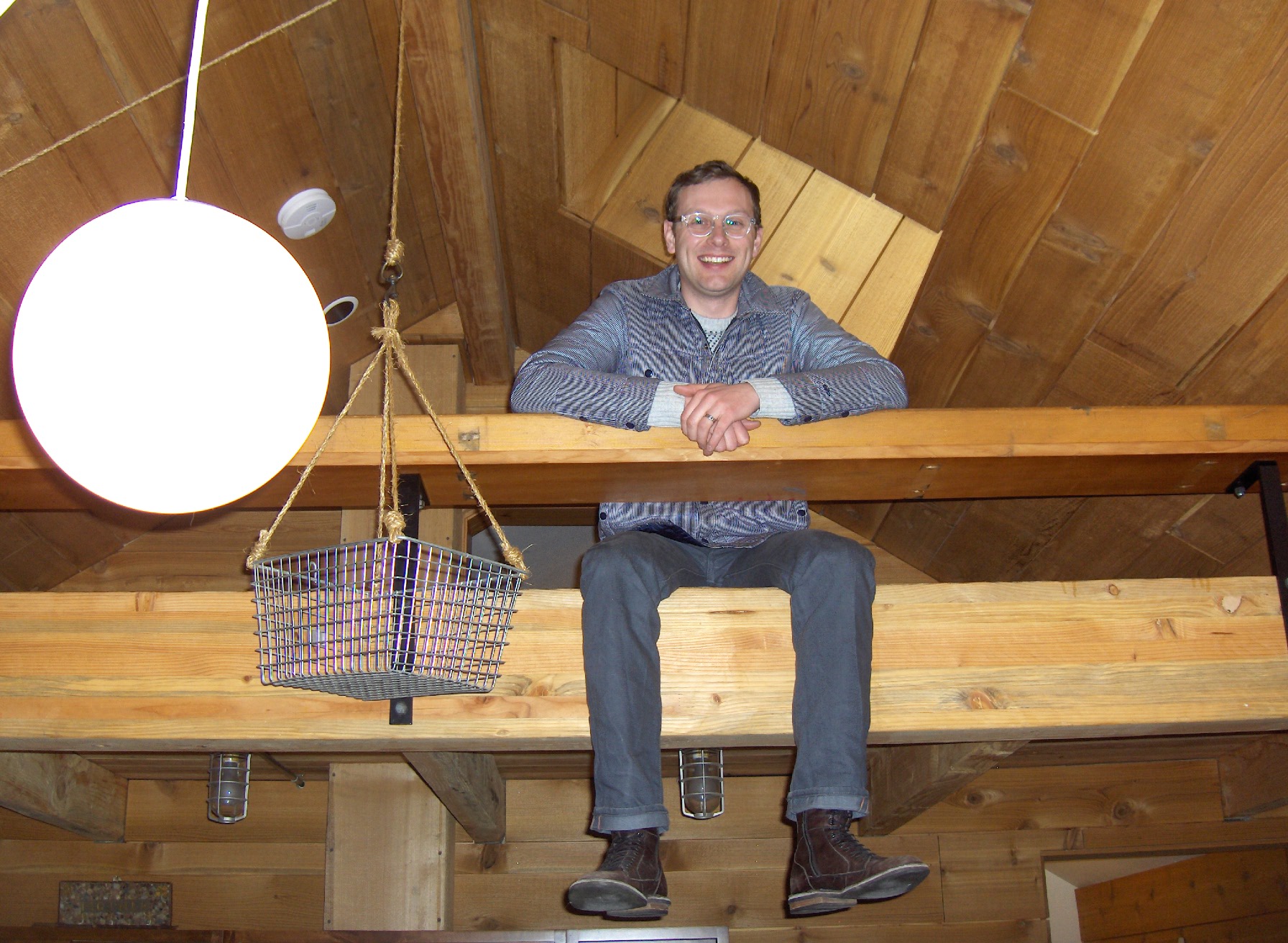 Another way of giving back lies in Dave’s touch with employees. Architect Jeff Guggenheim of Guggenheim Studio, who in 2021 won the AIA national Young Architect Award, remembers discovering the firm on a walk in his neighborhood, during a snow day, seeing Dave and Tim through the window of their storefront space, still working. “I hadn’t been planning to apply for a job, but the storefront and their presence in the neighborhood was very approachable,” he says.
Another way of giving back lies in Dave’s touch with employees. Architect Jeff Guggenheim of Guggenheim Studio, who in 2021 won the AIA national Young Architect Award, remembers discovering the firm on a walk in his neighborhood, during a snow day, seeing Dave and Tim through the window of their storefront space, still working. “I hadn’t been planning to apply for a job, but the storefront and their presence in the neighborhood was very approachable,” he says.
Guggenheim remembers being tutored by Dave in a way that helped him prepare to later co-found his own firm. “Once I started working for Dave, he did an excellent job walking me through how a drawing actually goes together, and how a building is designed: a really holistic approach to architecture that I appreciated,” he explains. “We even did all the structural drawings, which you would typically just outsource to your structural engineer. So early on I got exposed to every aspect of a project, which I think is really helpful, especially for someone starting out: the care that went into every project, and thinking through every detail and decision.”
Even when not receiving direct mentorship, just the openness of the studio helped Jeff learn. “The ability to listen in to meetings that maybe Dave was having with a client in the front room—hearing how he presented work and walked clients through the process—was really great too. Often at other firms the principals go off into the meeting room with the clients, and the young designers don’t get to hear those conversations. But there I could just be working at my desk and tune into the client happening in the front room.”
 Michelle Schulz, now a principal at Portland’s GBD Architects, came to what was then Giulietti & Associates as an intern, while completing her architecture degree at the University of Oregon’s Portland campus.
Michelle Schulz, now a principal at Portland’s GBD Architects, came to what was then Giulietti & Associates as an intern, while completing her architecture degree at the University of Oregon’s Portland campus.
“I remember my first day being so nervous, not knowing what to expect. But Dave was so welcoming to me,” Michelle wrote via email. “He spent time introducing me to everyone and talking me through all of the various projects the team was working on. He let me know that he wanted to allow me an opportunity to see all that went on in an architecture firm. And he was true to his word! I helped out with drawing changes on projects, I sat in on client meetings, I went out on construction sites, I helped run blueprints, I worked on our detail and specification library. You name it…I was doing it. Dave really brought me in as a part of the team, and it was great! I was lucky enough that after graduation he offered me a job.”
At the firm for nine years, Michelle worked with Dave on many projects, but remembers one in particular: 2005’s Leftwich Residence on Skyline Ridge in rural Multnomah County, with its commanding four-mountain view. “We were originally hired to do a remodel on the existing house, but during our initial design work the house had a fire—a tragedy that ended up allowing the couple freedom to explore the house of their dreams unencumbered: a forever home they could retire and grow old in. The design won awards, but the best award was homeowners that truly love their home,” she says. “They still live in that house today, and I happy to say I am still friends with them to this day, almost 20 years later. It’s the bond and connection to people and design that Dave taught me that I cherish the most.”
Into the Future (Jake Weber)
 To prosper over many years, an architecture firm must grow and change with the times. Partner Jake Weber credits Dave for not only acting as a mentor to young architects like himself, but also for embracing the opportunity to learn from a new generation and evolve. “Dave has always been totally open to how we can get better and offer more,” Jake says.
To prosper over many years, an architecture firm must grow and change with the times. Partner Jake Weber credits Dave for not only acting as a mentor to young architects like himself, but also for embracing the opportunity to learn from a new generation and evolve. “Dave has always been totally open to how we can get better and offer more,” Jake says.
When Jake joined what was then Giulietti Schouten in 2013, a year out of college and joining his first architecture firm, “Dave took me under his wing and showed me how to do things, and he immediately let me take the reins on a small remodel project,” he remembers. “I was even meeting with clients right out of the gate. And as the years went on and it became clear I was looking to grow within the firm, he really started opening up even more of the business side of the firm to me, helping me learn that as well.”
Even early in his tenure, Jake was able to return the favor by spearheading the use of 3D modeling and design software. GSW became able in time not just to map out every last millimeter of their designs, but to give their clients virtually an immersive sense of what was being produced. “It’s an impactful tool for us to use throughout the design process because it allows clients to see something that is close to reality,” Jake says. “Dave relied on me to research and show them what the possibilities were. He was always very open to progressing the firm’s capabilities.”
Embracing change goes beyond technology. Dave has trusted in Jake to help the firm embrace sustainable design choices, from energy-efficient architectural approaches to deeply researching materials chosen. And together with Tim Schouten, the firm is expanding its portfolio to include a growing list of commercial projects. That’s why one thing that won’t change is the name, because even if Dave is retiring, his imprint will always remain.
“We all agreed that the GSW name would live on from this point forward,” Jake says. “We’re definitely looking to expand the legacy of this firm into the next 35 years.”















